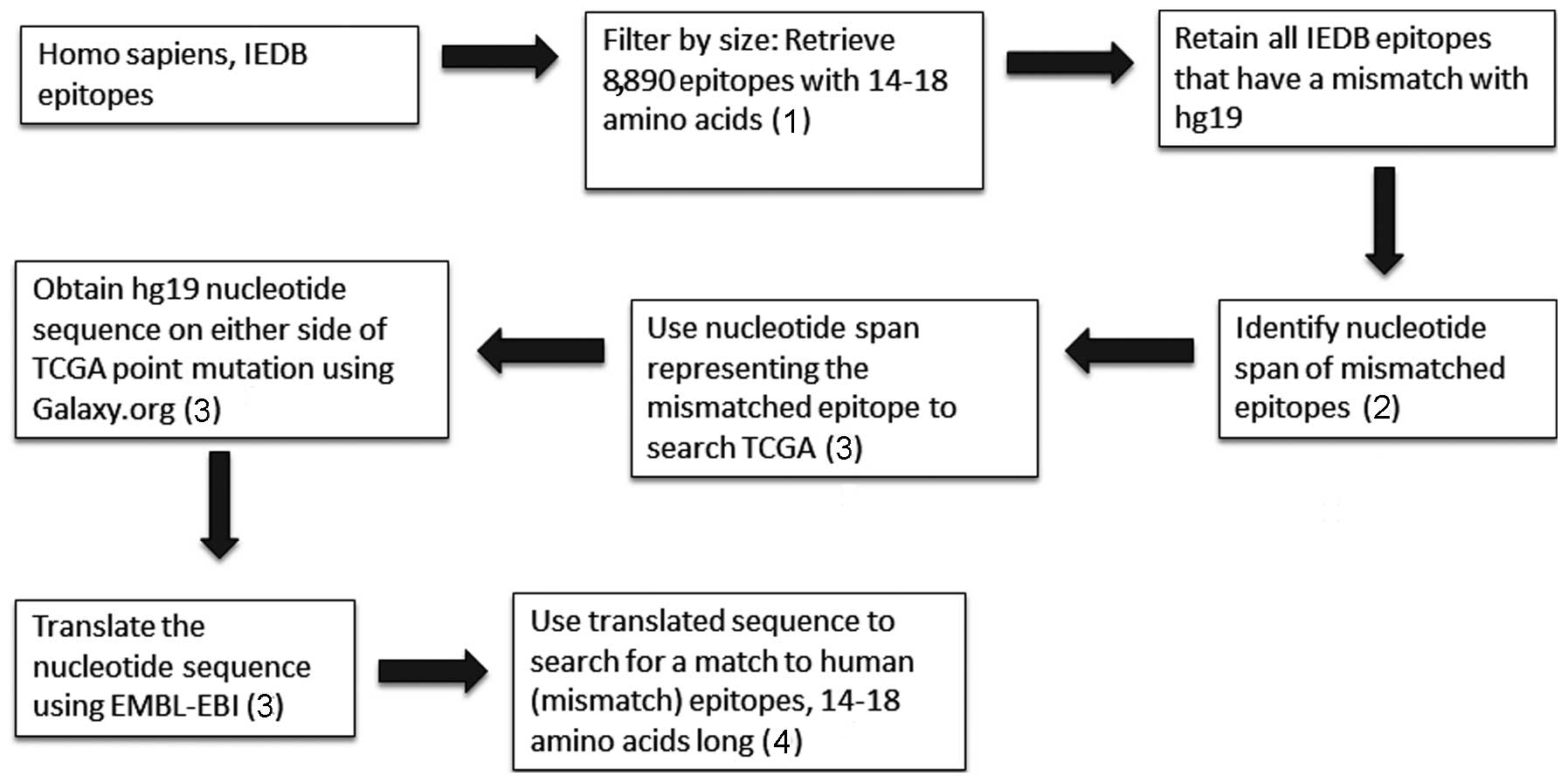
Overlap of the cancer genome atlas and the immune epitope database
- Authors:
- Shaimaa Sait
- Timothy Fawcett
- George Blanck
-
View Affiliations
Affiliations: Department of Molecular Medicine, Morsani College of Medicine, Tampa, FL 33612, USA, Department of Chemical and Biomedical Engineering, College of Engineering, Research Computing University of South Florida, Tampa, FL 33620, USA
- Published online on: August 10, 2016 https://doi.org/10.3892/ol.2016.4991
-
Pages:
2982-2984
-
Copyright: © Sait
et al. This
is an open access article distributed under the
terms of Creative
Commons Attribution License.
Metrics:
Total
Views: 0 (Spandidos Publications: | PMC Statistics:
)
Metrics:
Total PDF Downloads: 0 (Spandidos Publications: | PMC Statistics:
)
This article is mentioned in:
Abstract
Mutant peptides resulting from cancer drivers or passenger mutations are expected to have the potential to serve as a basis for cancer vaccines. However, a number of parameters regulate vaccine‑associated immunogenicity, including the suitability of a peptide for binding to an antigen‑presenting molecule or antibody. In order to obtain a basic indication of the prospect of human cancer epitope identification via current database development strategies, an overlap of the mutant Homo sapiens epitopes listed on the Immune Epitope Database (IEDB) and the mutant peptides indicated by The Cancer Genome Atlas (TCGA) somatic mutation database was obtained. No putative TCGA mutant peptides were detected among the 8,890 14‑18 amino acid (AA) IEDB peptides available. In total, 3 IEDB mutant epitopes that encompassed a TCGA mutant AA position, but did not overlap the exact position of the TCGA mutant AA, were detected. The results of the present analysis confirm that verification of certain aspects of cancer epitope function can be obtained via the continued and systematic expansion of databases representing human protein epitopes. However, the analysis also indicates that there is relatively limited systematic information available regarding antigen‑presenting molecule epitopes and cancer‑related mutant peptides.
View References
|
1
|
He Y and Xiang Z: Databases and in silico
tools for vaccine design. Methods Mol Biol. 993:115–127. 2013.
View Article : Google Scholar : PubMed/NCBI
|
|
2
|
Helmberg W: Bioinformatic databases and
resources in the public domain to aid HLA research. Tissue
Antigens. 80:295–304. 2012. View Article : Google Scholar : PubMed/NCBI
|
|
3
|
Akbani R, Ng PK, Werner HM, Shahmoradgoli
M, Zhang F, Ju Z, Liu W, Yang JY, Yoshihara K, Li J, et al: A
pan-cancer proteomic perspective on the cancer genome atlas. Nat
Commun. 5:38872014. View Article : Google Scholar : PubMed/NCBI
|
|
4
|
Parry ML, Ramsamooj M and Blanck G: Big
genes are big mutagen targets: A connection to cancerous, spherical
cells? Cancer Lett. 356:479–482. 2015. View Article : Google Scholar : PubMed/NCBI
|
|
5
|
Sait S, Fawcett T and Blanck G: Supporting
online materials for Overlap of The Cancer Genome Atlas and the
Immune Epitope Database. http://www.universityseminarassociates.com/Supporting_online_material_for_scholarly_pubs.phpAccessed.
June 10–2016
|
|
6
|
Parry ML and Blanck G: Flat cells come
full sphere: Are mutant cytoskeletal-related proteins
oncoprotein-monsters or useful immunogens? Hum Vaccin Immunother.
12:120–123. 2016. View Article : Google Scholar : PubMed/NCBI
|
|
7
|
Naba A, Clauser KR, Whittaker CA, Carr SA,
Tanabe KK and Hynes RO: Extracellular matrix signatures of human
primary metastatic colon cancers and their metastases to liver. BMC
Cancer. 14:5182014. View Article : Google Scholar : PubMed/NCBI
|
|
8
|
Cronin K, Escobar H, Szekeres K,
Reyes-Vargas E, Rockwood AL, Lloyd MC, Delgado JC and Blanck G:
Regulation of HLA-DR peptide occupancy by histone deacetylase
inhibitors. Hum Vaccin Immunother. 9:784–789. 2013. View Article : Google Scholar : PubMed/NCBI
|











